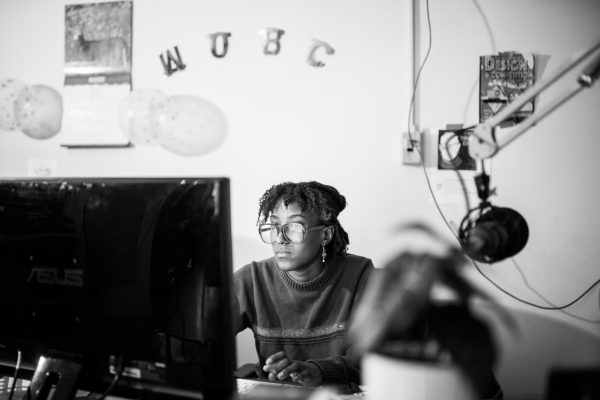Internment Exhibit Represents Integral Part of Oberlin History, Identity
Each year, we mark key anniversaries for events that transformed American life and history from December to February. On Dec. 7, 1941, the Empire of Japan attacked the United States Naval Base at Pearl Harbor, forcing us to decide whether or not to enter the Second World War. Over the ensuing months, officials debated what policies should be implemented to keep the nation secure, including the possibility of removing and incarcerating “enemy aliens” — even U.S. citizens — who might be loyal to America’s adversaries.
Feb. 19 also marks a particularly poignant anniversary for the nation, and especially for Japanese Americans. On that day in 1942, President Franklin Roosevelt issued Executive Order 9066, authorizing the forced removal and incarceration of more than 110,000 Japanese Americans — most of whom were U.S. citizens — on the West Coast. These people were forced to close their businesses, abandon their farms, leave their homes, and report to temporary assembly centers, many consisting of nothing more than converted horse stalls. From there, Japanese Americans were moved to one of ten incarceration camps in remote inland areas. In these “camps,” dotted with watchtowers and surrounded by barbed wire, Japanese Americans tried to create a semblance of normalcy in their confinement.
Though far from the West Coast and any of the camp locations, Oberlin College figures significantly in the history of internment, since it was one of several colleges that accepted students whose educations were disrupted by the war. When the war broke out, about 2500 Nisei — second generation Japanese Americans — were enrolled in West Coast colleges and universities. By spring 1942, various organizations came together as the National Japanese American Student Relocation Council to help coordinate the relocation of student internees into new schools outside the exclusion zone. Oberlin ultimately accepted dozens of former internees when the nation was still at war.
These students’ experiences are presented in an upcoming public history exhibit at the Baron Art Gallery, which opens on Feb. 17 — two days before the anniversary of EO 9066. As a result of a collective effort by faculty, students, staff, community partners, coordination by Chair of History Renee Romano, and support from the Go For Broke National Education Center, the exhibit is part of a ten-city traveling museum that “[unearths] a series of little-known but compelling examples of support and public spirit that supported the Japanese American community during and immediately after WWII,” according to the Go For Broke National Education Center website. Romano and Chair of Comparative American Studies Shelley Lee will also be teaching a module course on Japanese-American wartime incarceration and public history while the exhibit is still at Oberlin through mid-March. There will also be a series of speakers, performances, and other related events.
Japanese-American wartime incarceration is one of the most widely studied topics in Asian-American history, and it also looms large in the history of law and civil liberties in the United States. Though the episode is a familiar one in some respects, textbooks often reduce it to an aberration in an otherwise heroic war effort that secured and expanded democracy, and a historical arc that bends toward equality and justice. From a critical ethnic studies perspective, internment culminated decades of xenophobic treatment rather than deviating from an established pattern. Postwar celebrations of Japanese Americans’ resilience from their ordeal helped crystallize the “model minority” stereotype of Asians and glossed over the magnitude of their collective trauma. Those outside the experience learned about it in bits and pieces, and many former internees regarded silence about their ordeal as the price of moving on. Eventually, the silence broke and activism led by Japanese Americans — former internees as well as their descendants — determined to secure justice and heal their collective wounds surged, leading to federal redress payments and the rescinding of EO 9066.
Foundations that commemorate Japanese-American WWII veterans like Go For Broke, cultural productions like the musical Allegiance, and annual traditions like the Day of Remembrance ensure that we learn about and do not forget what happened. More recently, in the face of threats to civil liberties affecting Muslims and Arabs in America, Japanese Americans have been at the forefront of the pushback, reminding people of the tragedy of internment, and the mistakes we vowed never to repeat.
Another way that this history and the ghosts of EO 9066 reverberate at Oberlin is in the presence of current students — including two co-authors of this essay, Kenneth Kitahata and Mackenzie Lew — whose ancestors were interned and who now bear the intergenerational imperative to “never forget.” For us — Kitahata and Lew — memories of growing up are punctuated by stories of “the camps,” and what family and friends endured. Yet as fourth-generation Japanese Americans, we are more removed from internment than those before us, and are thus working out what it means to be part of this historical lineage. And while we may not yet know how internment will leave its mark on our generation and how we will shape internment’s legacy, for us, Oberlin now holds an integral place in our relationship to the past and our identities as Japanese Americans. It is where important history played out, where it is remembered, and where its meanings are continually remade through the activism of students, learning in the classroom, and commemorations that invite us all to pause and reflect.


